Apple’s iCloud is an easy to use solution for backing up photos, videos, documents and other important data from your iPhone, iPad and Mac. You can subscribe to various storage plans from £0.79/$0.99 a month to £6.99/$9.99 a month for 2TB.
It is possible to make a complete system backup of iPads and iPhones in iCloud and then use this backup to set up a new device with all the data and apps that were on your old device.
It’s understandable, therefore, that many Mac users wonder if they can back up their Mac to iCloud in the same way.
If you were hoping to backup your Mac to iCloud we’re here to explain what you can, and can’t, do.
Can I back up my Mac to iCloud?
The answer to this question depends on whether you want to back up your Mac or just store your content in the cloud. There’s a big difference between backing up and syncing content.
Every Mac, iPad and iPhone has access to an iCloud Drive. You can set your Mac to sync all everything on your Desktop and Documents folder to the cloud. This way every document you work on that is saved in either of those two locations will be available on all of your Apple devices.
This is handy if you use more than one Mac, if your Mac stops working, or if you lose or replace your Mac, because you can access all the files that are synced to iCloud.
If all you wanted to do was make a copy of some files and store it in iCloud you could easily create a folder on your Desktop and copy all the files into it, after which the files would upload to the cloud where they would reside, rather than on your Mac.
However, it’s not a backup because if you delete something that is in iCloud you cannot recover it. Nor is it a clone of your Mac that you could recover from if you had to wipe your Mac.
To make a true backup of your Mac you would need to use Time Machine or a similar solution. (See our round up of the best backup software for Mac).
Time Machine is the built-in backup feature that comes with a Mac. If you create a Time Machine backup you can use it to recover your Mac if you wipe it due to a problem or if you buy a new one and want to set it up exactly the same.
Time Machine also makes hourly, daily, and weekly backups so you can use your Time Machine backup to go back to a previous version of a document, or to recover something you have deleted. Read how to back up your Mac with Time Machine.
The problem with Time Machine is that it requires a large external storage device – your Time Machine drive needs much more storage space than your Mac. It’s no wonder that people who are paying Apple for 2TB of iCloud space are wondering whether they can use Time Machine to backup their Mac to iCloud.
And this is where we hate to disappoint you, but the answer is no. You cannot currently use iCloud for a Time Machine backup. We do really hope that changes though. Fingers crossed for macOS 12.
What does iCloud back up?
As we explained above, you can’t use iCloud to make a Time Machine backup of your Mac, but it does offer quite a lot in terms of the files it can store:
- Desktop Folder
- Documents Folder
- Photos
- Music
- Messages
- Some application data
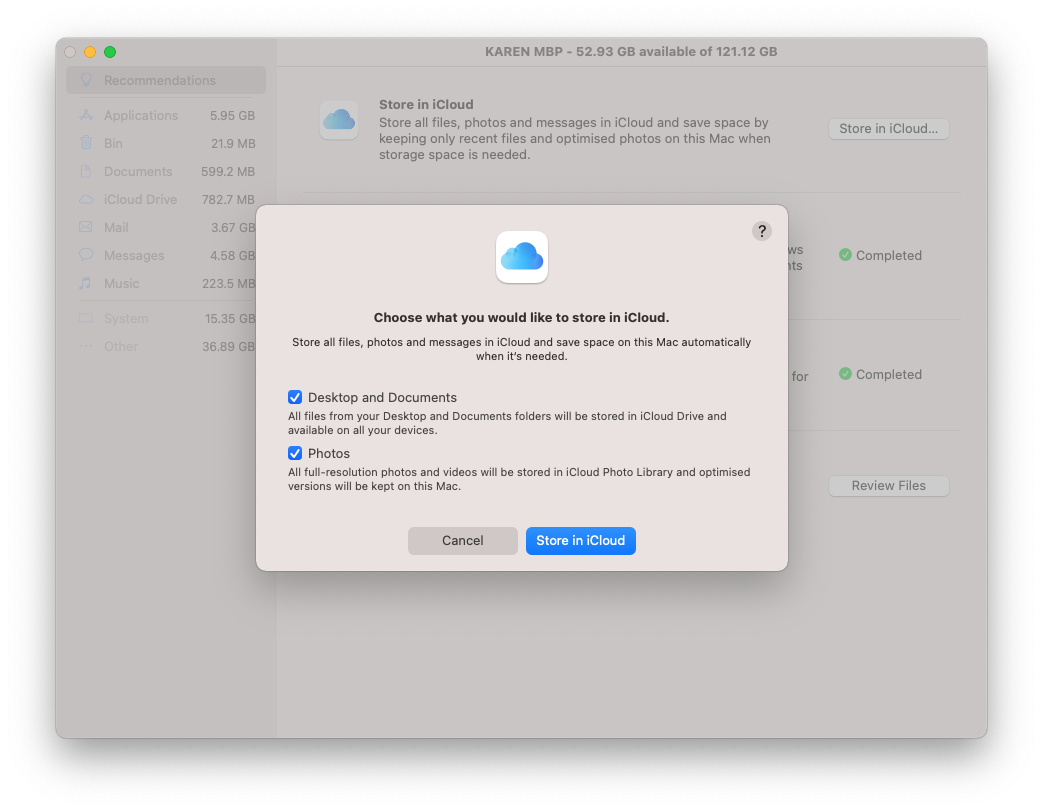
How to store Desktop & Documents folder in iCloud
By setting up your Mac so that everything you are working on is stored in the cloud you can save a lot of space on your Mac and easily access all your files from any device.
Do remember though that this isn’t a back up – unless you make a physical copy of the files yourself. If you delete a document or save over it you won’t be able to recover the old version.
- Click on the Apple logo in the left of your screen.
- Select About This Mac.
- Click on Storage.
- Click on Manage.
- Select Store in iCloud.
- You can select Desktop and Documents here (you can also select Photos – more on that option below).
Now the Desktop will be identical on every Mac you use, so if you save documents, images, screenshots and anything else here you will be able to access it on your other Mac – handy if you have a Mac at home and one at work.
How to store photos in iCloud
Follow the steps above but choose the Photos option. This will turn on iCloud Photo Library.
With iCloud Photo Library turned on every photo or video you have in the Photos app on your Mac will be stored in iCloud, along with all the photos in your Photos app on your iPhone and iPad.
If you have a lot of photos taking up space on your Mac this is a great way to recover some space because you can transfer the full-res versions to the cloud and store only thumbnails on the Mac until you need them.
You can set up iCloud Photo Library in the Photos app on your Mac.
- Open Photos.
- Click on Photos > Preferences in the menu.
- Click on the iCloud tab.
- Tick (check) the box beside iCloud Photos if it’s not already selected.
- Select Optimise Mac Storage.
This Optimise Mac Storage option will mean that the original, high-res versions of your photos are stored in iCloud rather than on your Mac.
However, you should be aware that this is not a suitable way to back up your photo library if you were hoping that once your photos were in iCloud you could delete them from your Mac. If you were to delete a photo from your Mac you would also delete it from iCloud.
iCloud Photo Library is only really an option if you have adequate space in iCloud to store the photos. If you don’t fancy paying to store 100s of GBs of images in the cloud then you might like to consider using My Photo Stream as an alternative.
As we explain in iCloud Photo Library or My Photo Stream: Which is better? Apple allows you to store the the most recent 1,000 photos or the last 30 days of images in iCloud for free, which means you can access them on all your devices.
This means that if the worst happens you should always have a backup of the last 30 days or photos, or your last 1,000 photos, which ever is greater.
How to store music in iCloud
Music, like photos, could be taking up a lot of space on your Mac. In which case you might be glad to learn that you can store all your music in iCloud.
To do so you can either turn on iCloud Music Library or use iTunes Match. Which one you use will depend on whether you subscribe to Apple Music.
If you subscribe to Apple Music (£9.99/$9.99 a month for access to Apple’s entire music library) it essentially includes the features of iTunes Match (which otherwise requires a yearly subscription of £21.99/$24.99). We compare the two services here: iTunes Match vs Apple Music.
If you don’t want to subscribe to Apple Music then iTunes Match allows you to store 100,000 songs in iCloud – this actually means that Apple is ‘matching’ your music to tracks in Apple Music and uploading any that aren’t. You can then delete the music from your Mac – as long as you are happy to keep paying that yearly fee to maintain access.
To make sure your music library syncs to the cloud follow these steps:
- Open the Music app.
- Click on Account and sign in with your Apple ID if you aren’t already signed in.
- Click on Music > Preferences.
- Click on General.
- Choose Sync Library. (This option will only be visible if you subscribe to Apple Music or iTunes Match).
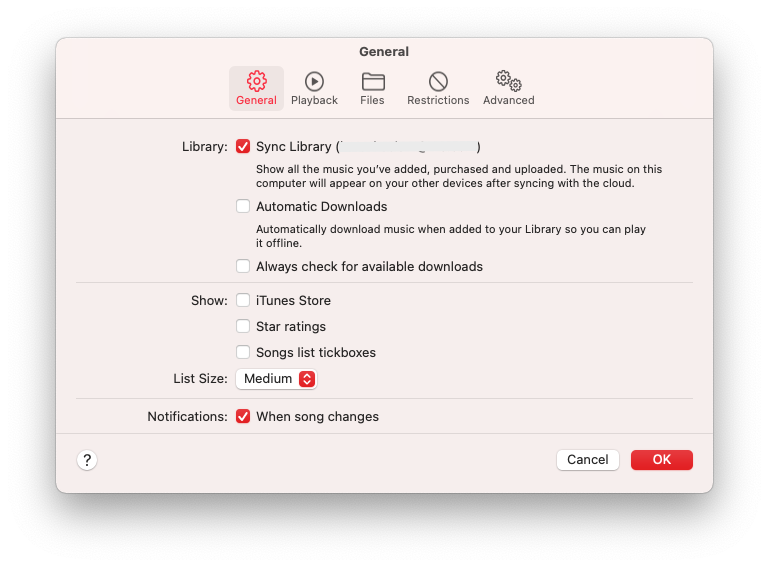
What doesn’t iCloud back up?
As we outlined above, you won’t be able to store a Time Machine backup or a clone of your system in iCloud. This means that any settings or preferences you may have set up on your Mac, won’t make it to another Mac via iCloud. That would require a Time Machine backup.
The same is true of any apps or media not bought on the App Store or iTunes store, unless you make a copy of them in your iCloud Drive.
If you want a complete clone of your Mac, then you’ll either want to setup a Time Machine backup or use one of the packages included in our roundup of the best backup software for Mac.
How to see what is backed up in iCloud
You can investigate what is being synced to iCloud by viewing your Apple ID settings in System Preferences:
- Open System Preferences.
- Click on your Apple ID to open the iCloud section. Here you’ll see which types of files from your Mac (and other Apple devices) are currently being stored in iCloud. These include Photos, Mail, Contacts, Calendars, Reminders, Notes, preferences and bookmarks for Safari, Keychain passwords, and a few app-specific items.
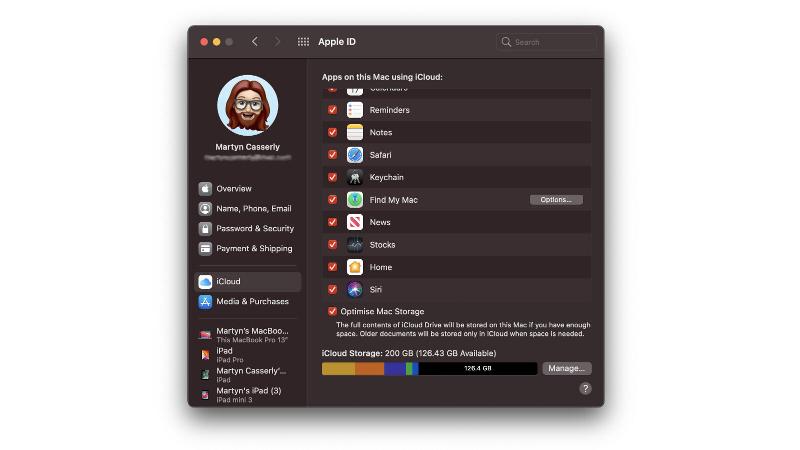
- You’ll also notice an iCloud Drive option at the top of the list. Clicking the Options button to the right of it shows which apps are currently using iCloud Drive to store files and data (predominantly Apple’s own apps).
- You can delve further into iCloud Drive by opening Finder and selecting iCloud Drive from the iCloud section.
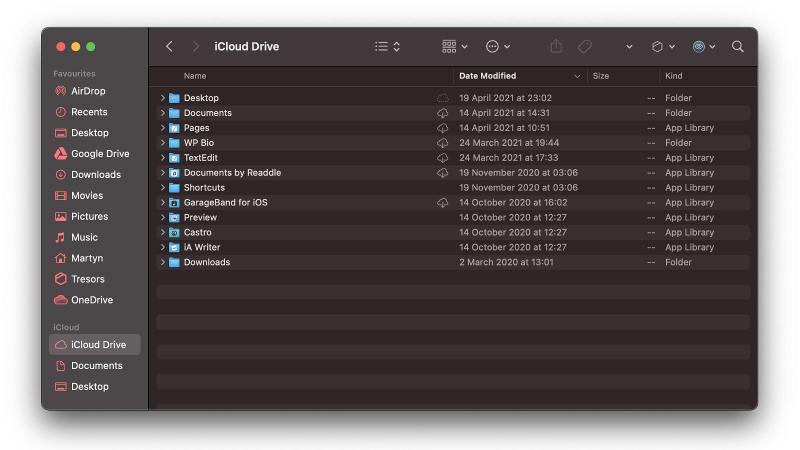
Of course, you can also create new folders and drag other files into iCloud Drive if you want. Although, be sure that you have enough storage available in iCloud to accommodate the things you want to add. If there isn’t, then read how to increase your iCloud storage.
Any apps, music, movies or TV shows you’ve bought on the App Store or iTunes Store will also be attached to your iCloud account, so you’ll be able to easily install them on a new Mac just as you would with an iPhone.
How to access iCloud on a Mac
Wondering where the iCloud folder is on your Mac? It’s known as the iCloud Drive and you can find it in the Finder.
Open the Finder and scroll down the column on the left and you’ll find it under iCloud.
You’ll see the iCloud Drive as well as your Desktop and Documents folder here (if they are in the cloud).
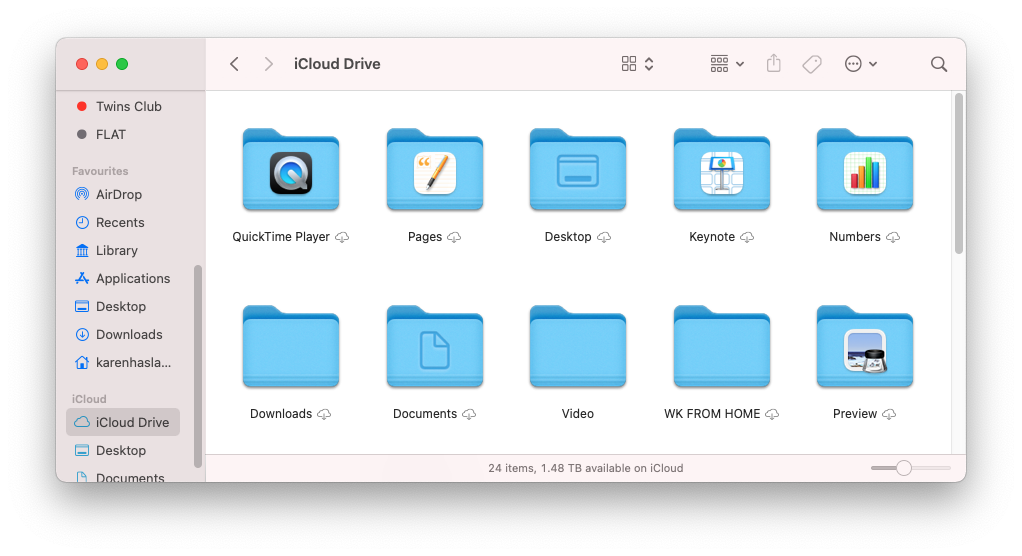
This can be a bit confusing because you may assume your Pages documents, for example, will be located in Documents, but they are actually in the Pages folder in iCloud Drive. You could use the Documents folder to store other files and folders that aren’t associated with Apple apps that are automatically synced to iCloud.
If you want to save something to iCloud make sure you choose one of these iCloud locations – Desktop, Documents, or one of the folders in iCloud Drive. The folder will have iCloud next to it.
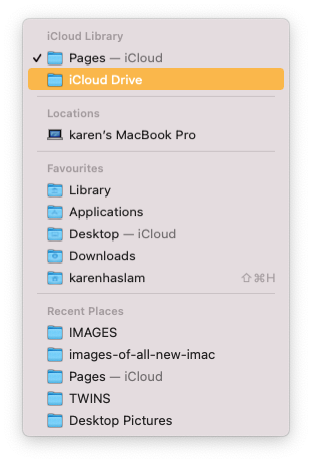
What’s the best way to back up my Mac?
There’s an old adage in digital security that goes along the lines of “if you only have something backed up once, then it isn’t backed up at all”. The principle being that you should always have multiple backups of important files, just in case you have a disaster with your machine, only to find out that the solitary backup you were hoping would save you has also failed or become corrupted.
With this in mind, we would recommend a full system backup (such as Time Machine) that you run regularly, plus using cloud storage solutions (such as iCloud) to make additional copies of files.
You’ll find more details on the best methods of achieving this in our how to back up a Mac article. Of course, you don’t have to use iCloud, as there are also plenty of other alternatives, such as those we highlight in our guide to the best Cloud storage services for Mac. Ideally, sign up to several and keep your files on all of them. This should mean that if the worst happens, you’ll have plenty of options to recover your precious data.
